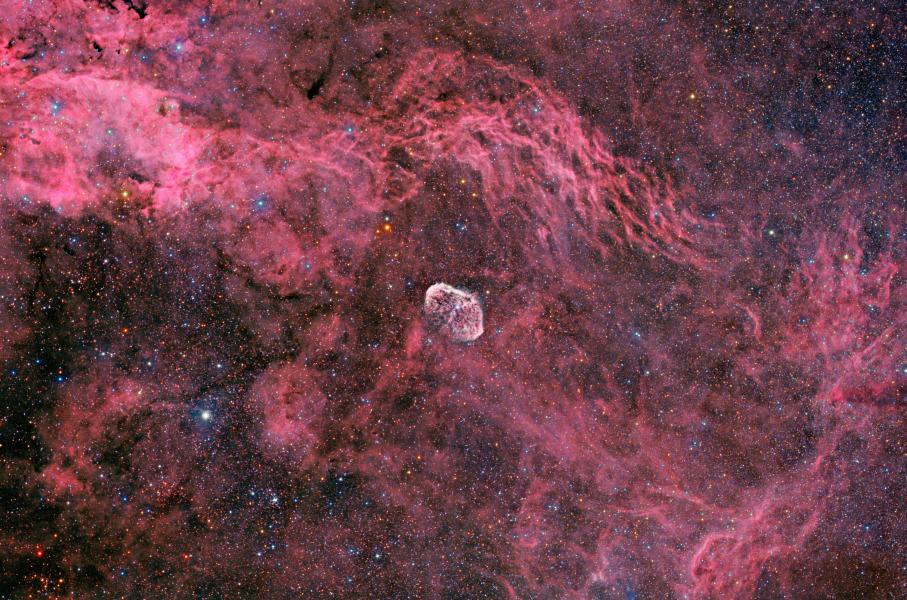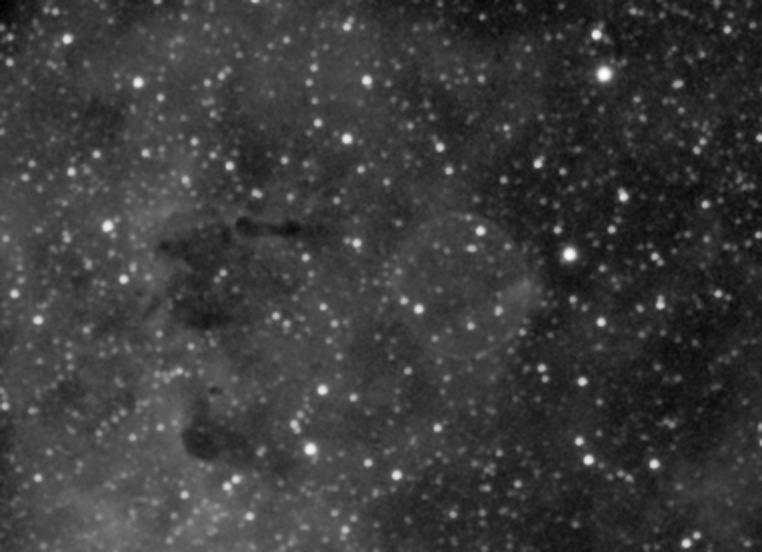NGC 6888, the Crescent Nebula |
 |
| NGC 6888, also known as the Crescent Nebula, is
also catalogued as Sharpless 105 and Caldwell 27. It is an
emission nebula in the emission-rich constellation Cygnus. Its
crescent shape is visible in telescopes and wideband (i.e.,
LRGB/RGB) photographs. The fine tendrils inside the crescent
shape are visible in images shot through narrow-band filters.
Had those tendrils been visible in the past, this object might
have been nicknamed the Moon Jelly Nebula instead. The Crescent Nebula was formed by the fast stellar wind of WR 136 (the bright star near the center of the nebula). WR 136 is a Wolf-Rayet star which is a massive star that is approaching the end of its life. According to entries in Wikipedia, WR 136 has 15 times the mass of our Sun and and is 250,000 times brighter, with a surface temperature of about 70,000 Kelvin (vs. about 5,800K for the Sun). Note: 0 Celsius = 273K Wolf-Rayet stars are defined as stars that were 20 times the mass of the Sun initially that are now losing mass via a strong stellar wind. In the case of WR 136, it is estimated as starting off with a mass of 30 times the Sun. Around 250,000 years ago it became a red supergiant and blew off an outer layer of its material, trimming its mass down to the current estimate of 15 solar masses. It is now shedding more mass via the fast stellar wind that is characteristic of a WR star. This fast wind is catching up with the material ejected in the past, creating the shape we see now. As with most emission nebulae, UV radiation from WR 136 is causing the material of this shell to glow. One other tidbit about WR 136: it is estimated to be 4.5 million years old, which makes it a youngster compared to our Sun's 4.3 billion year age. It is burning fast and furious thanks to its mass, and will likely become a supernova in the next few million years. I've highlighted another interesting object in this image. The "Soap Bubble" Nebula is a planetary nebula discovered back in 2007-2008 by amateur astronomer David Jurasevich. It is a very faint nebula that was probably visible in many widefield images of this region but only noticed and reported in 2007/2008. It was given the official designation PN G75.5+1.7 by the International Astronomical Union in 2009. Which goes to show that even today, there are many hidden treasures in the night sky! While I've marked the location of the Soap Bubble in the annotated version of the image above (hold the mouse pointer over the above image to see the annotation), it is tough to spot in the full-size. Which explains its "hidden in plain sight" nature. I am not giving my due to the many other objects in this FOV. I honestly don't know their designations as of this writing. But as can be seen, there is a lot of emission nebulosity in this area. The above image is a highly-compressed version of the full image. Please click on that preview image to see a 75%-sized view. A 200%-sized crop of the Soap Bubble Nebula in H-alpha greyscale is showcased below. |
| Constellation: Cygnus |
| When Visible: July - December |
| Distance: 5,000 Light-years |
| Date: June (H-alpha data) and September (RGB data) 2013 |
| Location: Rancho Hidalgo, Animas, NM |
|
Exposure Details: H-alpha: 15 x 30 minutes Binned 1 x 1 R: 9 x 10 minutes Binned 1 x 1 G: 9 x 10 minutes Binned 1 x 1 B: 9 x 10 minutes Binned 1 x 1 12 hours total exposure time |
| Equipment Used: Takahashi FSQ-106N on an Astro-Physics AP1200GTO mount. SBIG STL-11000 camera with 5-position filter wheel and Astrodon filters. Robofocus focuser. Externally guided with an SBIG Remote Guide Head on a Borg 50Ach refractor. |
| Acquisition Software: MaximDL, TheSky6, CCDAutopilot |
| Processing Software: MaximDL, Photoshop CS5, IrFanView, HLVG Plugin, Carboni Actions |
| The large image linked to above is only 75% of the original sized image. Here is a 200% sized crop of the Soap Bubble Nebula and the area around it: |

|
